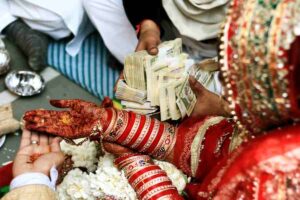
“Will you marry me?” A very fetching question popped by people in romantic relationships but ironically it is dissociated from the meaning of ‘marriage’ that has been practiced in India since ages. Indian Marriages was and is a ‘deal’ of the union of two families rather than the union of two hearts. “You don’t marry an individual, you marry a family” is a common phrase here in India. It’s an alliance negotiated by families where grandparents, parents, siblings and an entourage of cousins, per se, are part of the ‘deal’. Traditionally marriages are designed to connect families to expand their zones of influence and maintain financial security for the time to come. Now, it would be interesting to ask “How do families manage to ‘seal this deal’? Practiced since antiquity, Bride Price and Dowry enabled sealing of this deal- establishing a long term relationship of benefits.
Social anthropologist Stanley J Tambiah says dowry, as described in “Manusmriti” or the “Code of Manu” are the sanctioned and prestigious “love gifts” given by the Brahmin families in the Vedic period whereas “Bride Price” is mentioned as valuables given by the groom’s family (lower caste) to the bride’s when brides are in a scarcity or the bridegroom is in no way a match for the bride. The studies of Sanskrit scholars Mc Donell and Keith further finds that these love gifts ( 200 BCE-700 CE) were given away as part of the woman’s inheritance in the form of gifts(dowry)-cash, jewellery and property at the time of her marriage. A thought provoking question here would be “What is the impact of these gifts(dowry) on the bride in this social, political and economic union of the families?”Financial security, economic freedom and status were some of the privileges dowry brought for the bride as she stepped into her new family she is married into. In case of an absence of a contingency fund or if she chooses to leave her husband, she could use these ‘gifts’ to maintain herself and her children.
‘Marriage of the families’ and its outlook remained unchanged with passage of time, but what changed was the aim of dowry and its impact on the bride. Dowry became a weapon of exploitation. Around the late eighteenth century, families started looking at dowry as a tool to enhance social status, financial stability and a ladder for their upward mobility . Veena Talwar, author of ‘Dowry Murder; The Imperial Origins of a Cultural Crime’ blames the British for bringing about this offensive perception. According to her, it all started with the British introducing ‘Permanent Settlement’ in Bengal (1793) by Lord Cornwallis. Until then land was not seen as a commodity that could be bought or sold by anyone. It belonged to the king and no one could evict the peasants settled there. This new policy created new private landowners. The ‘Zamindar’ who was initially just a tax collector to the government was now a powerful landlord who owned vast tracts of land. She further states “Putting landed property exclusively in male hands like this, and holding the latter responsible for the payment of revenue had the effect of making the Indian male the dominant legal subject”. And thus, the systematic clipping of the women’s wings began. The first blow to a woman’s liberty came in the form of an evolved version of the Permanent Settlement which prohibited women from owning any land.
Accordingly, all landed wealth held by a woman, now, had to be transferred to her husband thereby changing her role from co-partners at home and in landholdings to that of a servant. Her servitude began at an early age where she was expected to serve her father and brothers and carry on the practice after marriage till death. Devoid of a financial purse, household chores, bearing children and giving care became a wife’s primary role while her husband became master of the house and finances. This shift in power dynamics found women at its receiving end. Decision-making became an entirely male prerogative. Since she was bereft of any financial independence or entitlement whatsoever, it made her maintenance be seen as burdensome by the ‘men’ in her family. So, as per them, dowry was the only compensation that would cover the expense incurred by a woman. These manipulations came to be the most dangerous one, giving a blow to her identity.
Veena Talwar further explains that the British started recruiting more peasants from the Punjab region into the army. There was already a disrupted gender and power dynamics playing in the background. The new found status saw families now demanding more dowry unlike in the past where it was given. Dowry price varied across caste and class stratifications. Higher the social class, caste, educational qualifications and income of the groom, higher were the dowry quotes. The grooms from the lower caste demand less but that itself is an ordeal for the poor families. Thus,these families get caught in a vicious cycle of mortgaging and loans The Dalits, for example, send their sons to bonded labour in order to collect dowry for their daughters. Many cotton farmers were pushed to suicide due to failed crops and inflating dowry prices that led to unmanageable debts. Whether upper caste or lower-non-payment of dowry would result in abuse, violence and even death of the bride thereby giving it a sinister tone. In the wake of such hard hitting scenarios female infanticide, skewed gender ratios or preferrence for a male child became common in the indian society. Equality started alluding to women-the final blow!
Can women and her family get some refuge from this ordeal? Article 3 of the Dowry Prohibition Act of 1961 and Sections 304B & 498A of the Indian Penal Code both state dowry as punishable by law. Whether these judicial remedies really save women and their families is debatable but what is non-debatable is that a recourse can only be provided by the educated youth of this country. The patriarchal norms do not allow men to detach themselves from their familial bonds when it comes to their marriages. This is exactly where they need to break the shackle and take a stand. It’s time for them to discard the purpose of marriage as a ‘union of families’. Women need education that is outside the realm of conventional and conservative schooling which will teach them to question patriarchy. Women’s true liberation and financial independence are the byproducts of that kind of an education which will herald new beginnings.

Bincy Thomas
Bincy was a teacher by profession but now, is a history buff by choice. Being a fitness enthusiast with a keen interest for trekking, she combines this interest with history and sets out exploring lost and forgotten monuments, to gather new insights and information. When she’s not trekking, yoga, meditation and reading takes away her time.

